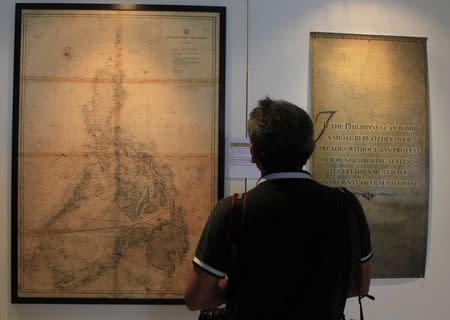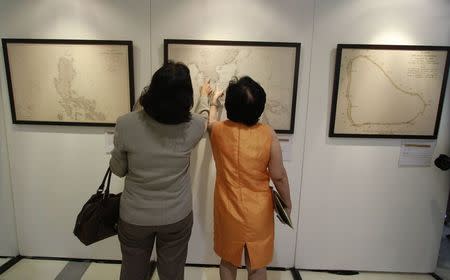Philippines displays ancient maps to debunk China's sea claims
By Manuel Mogato MANILA (Reuters) - The Philippines on Thursday put on display dozens of ancient maps which officials said showed that China's territorial claims over the South China Sea did not include a disputed shoal at the centre of an acrimonious standoff. The Philippines is in dispute with China over parts of the South China Sea, including the Scarborough Shoal, an area believed to be rich in oil and natural gas as well as fisheries resources. China seized control of the shoal in June 2012 and has prevented Philippine fishermen from getting close to the rocky outcrop, a rich fishing ground. Philippine officials said the exhibition of old maps at a university showed that for almost 1,000 years, from the Song Dynasty in the year 960 until the end of the Qing Dynasty early in the 20th century, China's southernmost territory was always Hainan island, just off the Chinese coast. "We should respect historical facts, not historical lies," said Supreme Court Associate Justice Antonio Carpio, who has done extensive research on the territorial disputes. The facts were graphically illustrated on the ancient maps, both official and unofficial, he said. Carpio said the exhibition could be viewed online and it would help everyone in all claimant states understand the facts, "either to restrain extreme nationalism fuelled by historical lies or give hope to a just and durable settlement of disputes". China claims nearly the entire South China Sea. But Brunei, Malaysia, Vietnam and Taiwan also have claims in the sea, which is traversed each year by ship-borne trade worth about $5 trillion. Exhibition organisers said the Scarborough Shoal never appeared in any old Chinese maps. But on numerous ancient maps made by foreigners and Filipinos, from as early as 1636, the rocky outcrop was consistently shown to be Philippine territory. Carpio, in an earlier lecture, said the shoal was also used as a naval gunnery range by U.S. and Philippine armed forces from the 1960s to the 1980s, and neither China nor any other country protested against the bombing practice. In June, China unveiled a new official map of the country, giving greater play to its claims on the South China Sea. The Philippines, a close U.S. ally, has brought a case to the U.N. arbitral court in The Hague, seeking clarification on its entitlements under the U.N. Convention on the Law of the Sea. China has refused to take part in the arbitration. A ruling is expected late next year. (Editing by Robert Birsel)




